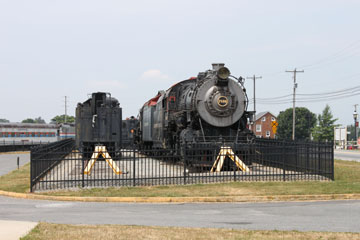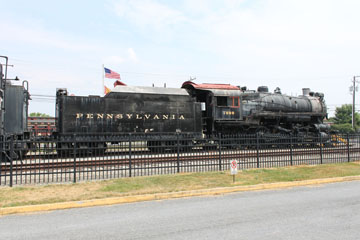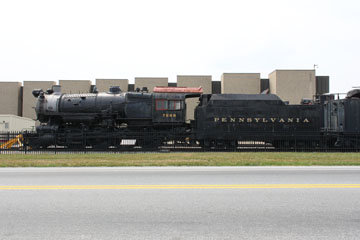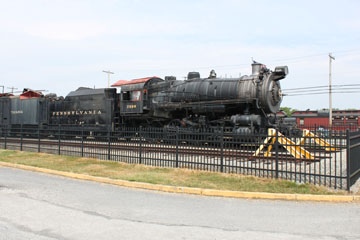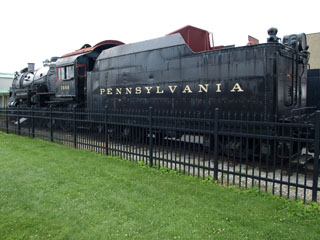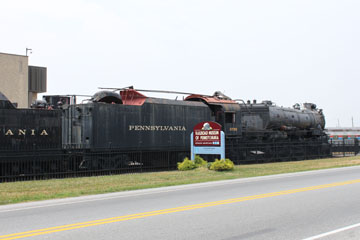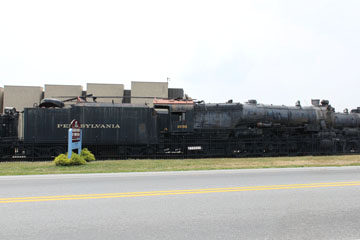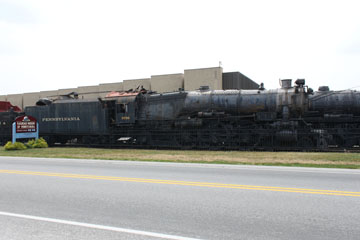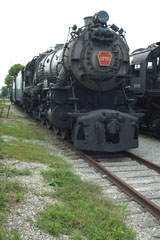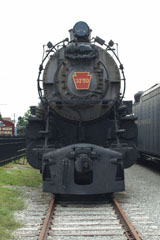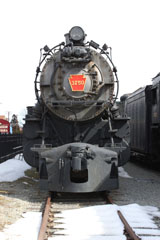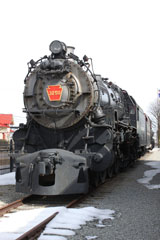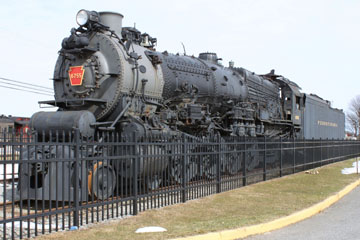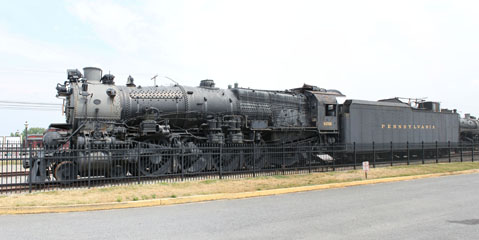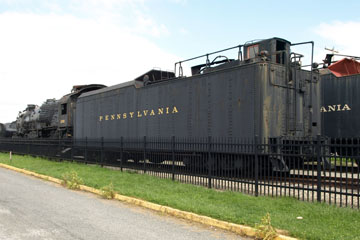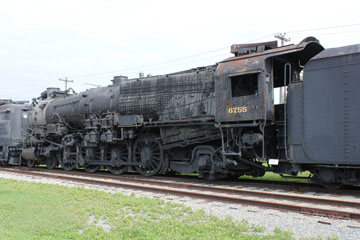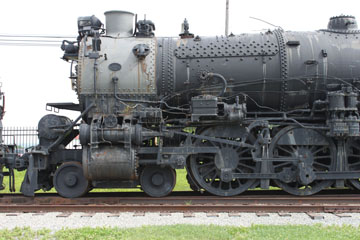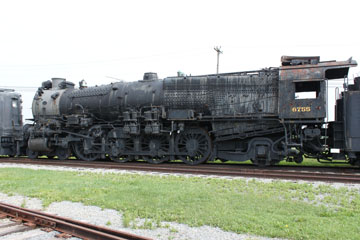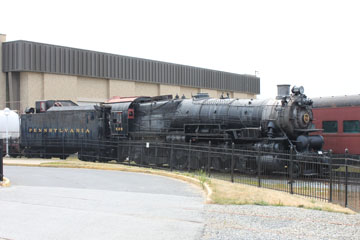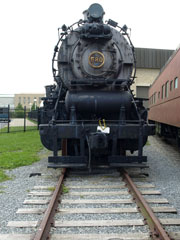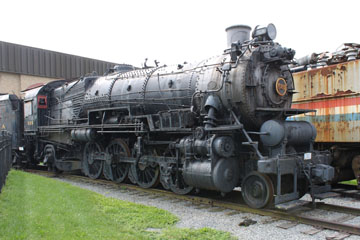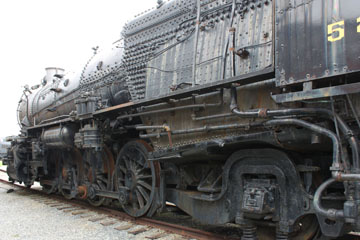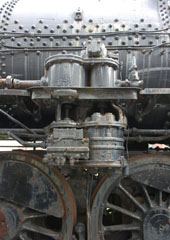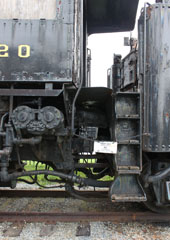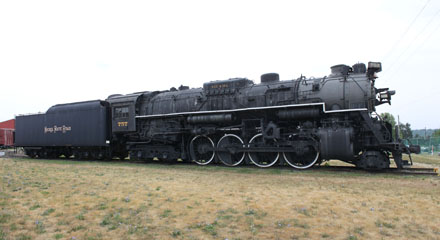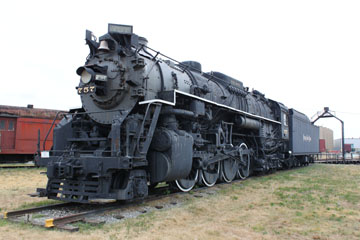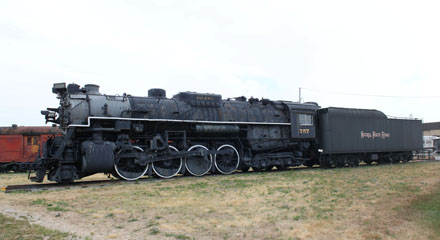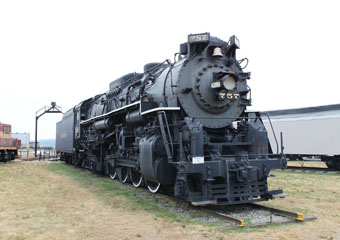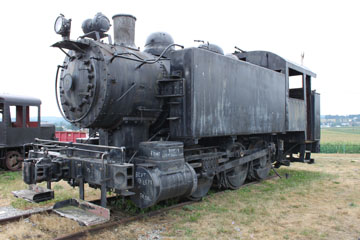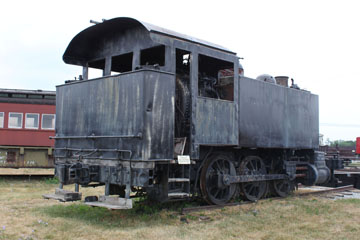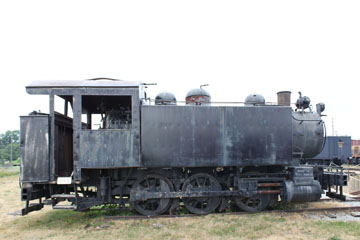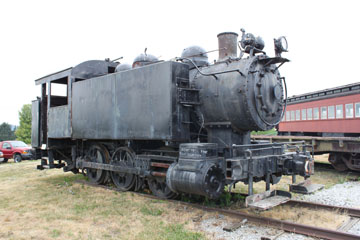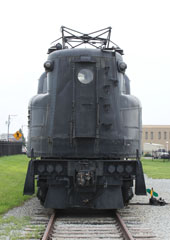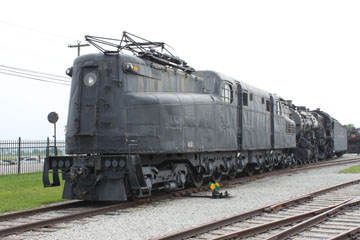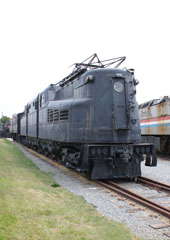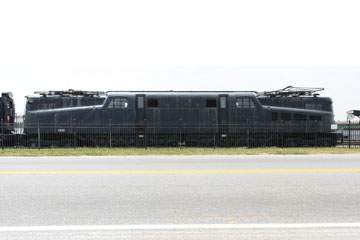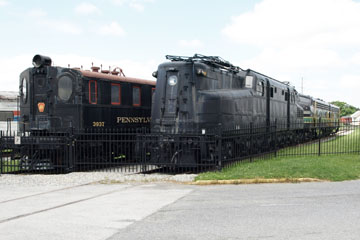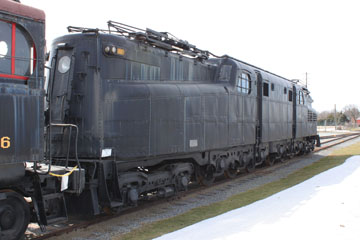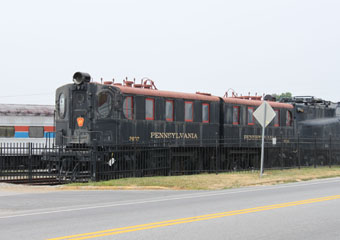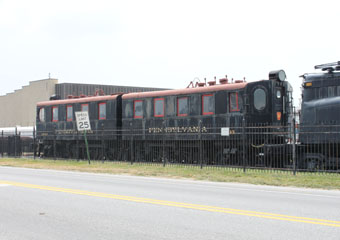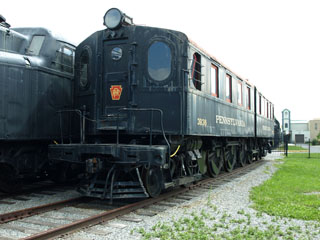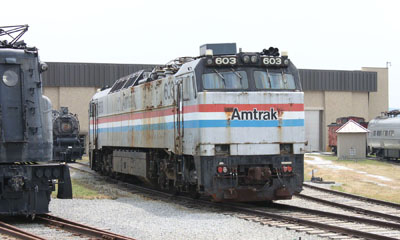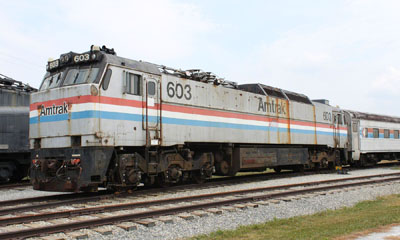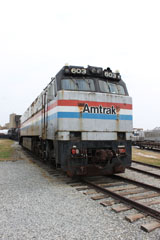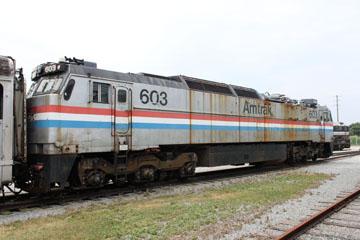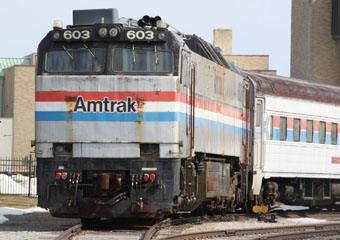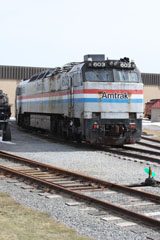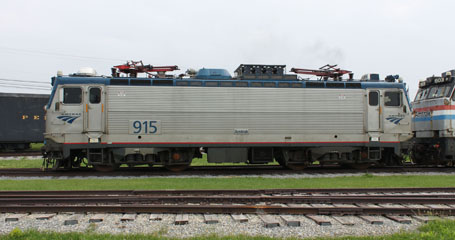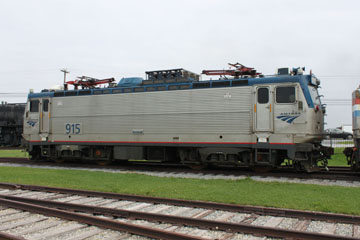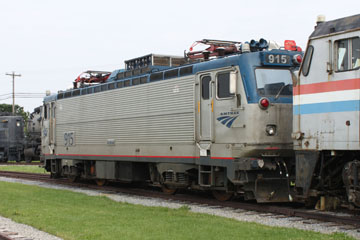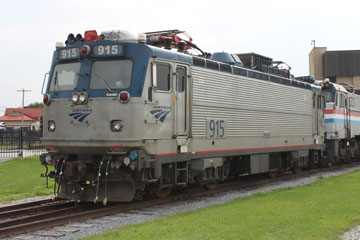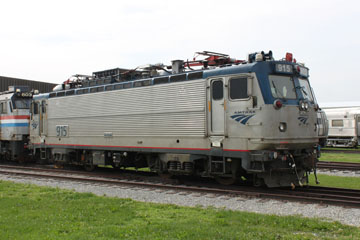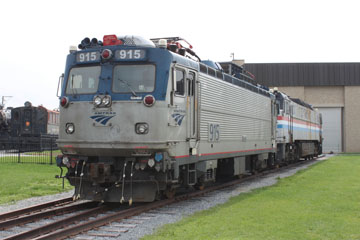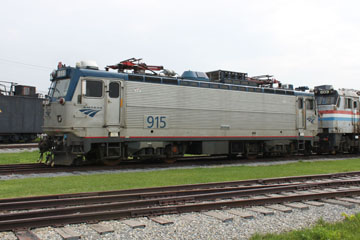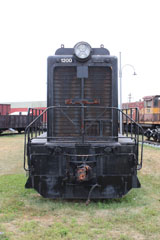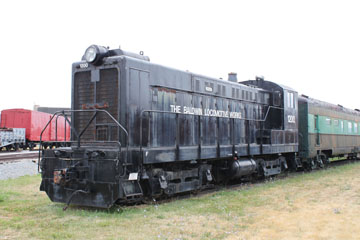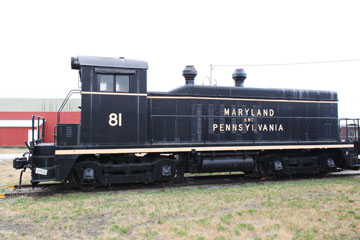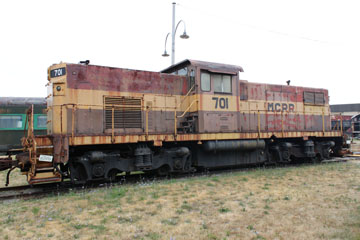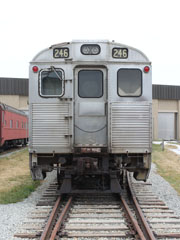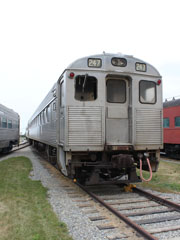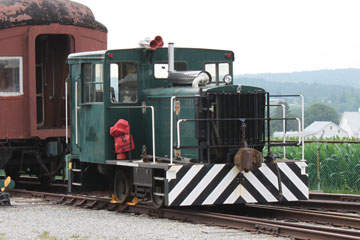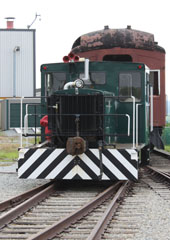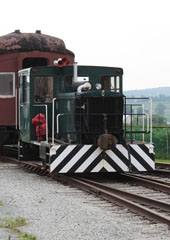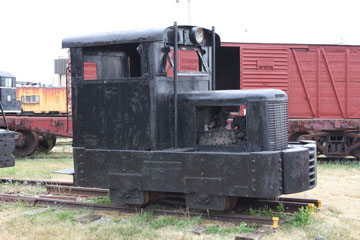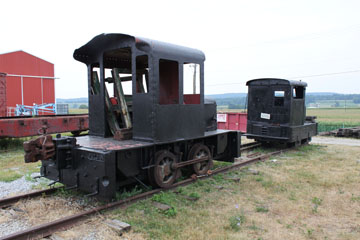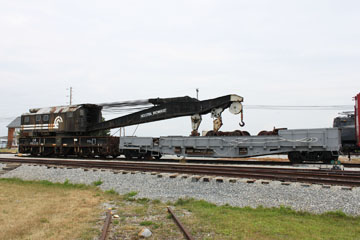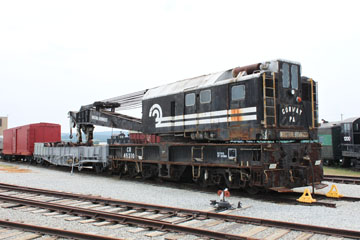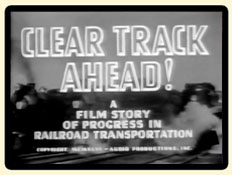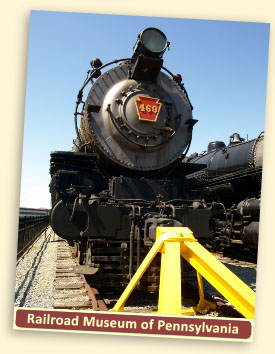

The Railroad Museum of Pennsylvania is administered by the Pennsylvania Historical and Museum Commission with support from the "Friends of the Railroad Museum". It was created to provide a historical account of railroading in Pennsylvania but also has some items from outside the state.
There is a great deal in the collection, so I have split my photographs of it over two pages. This page has equipment displayed outdoors. The Railroad Museum of Pennsylvania Train Shed page has photographs of equipment displayed indoors.
I have been to the museum frequently since 2004 and the
photos on this page are from various visits.

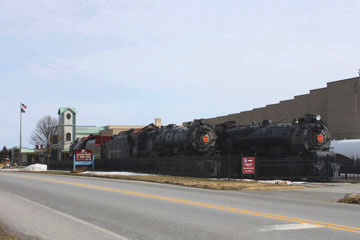
The museum is located on Gap Road / Pennsylvania Highway 741, close to the township of Strasburg, PA, and is open Tues-Sat 9.00am-5.00pm and Sunday 12.00pm-5.00pm. Just across the road, the Strasburg Railroad offers steam rides on selected days between April and December (you can see photos of four of the locomotives under steam on the Strasburg Railroad page of this website)
Most of the museum's collection comes from the Pennsylvania Railroad. Over time, the Pennsy saved some of its steam locomotives for display or posterity and stored them in its Northumberland, PA, engine house. With the State of Pennsylvania seeking to set up a railroad museum and Penn Central, PRR's successor, wanting to get rid of the collection in the late 1960s, the equipment was moved to a new museum site in Strasburg.
A number of locomotives are currently outdoors. This is not ideal, as most of the steam locomotives have been stripped of their jacketing to remove lagging and minimise damage caused by damp and rust. However, construction of a $5 million roundhouse is underway, which will provide much better display conditions.

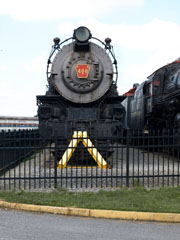
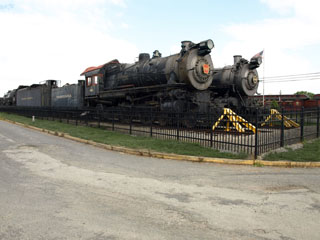
The E6 class Atlantic type (4-4-2) was developed by the PRR to haul heavier all-steel passenger cars entering service in the 1900s.
The first E6, #5075, was delivered from the Juniata Shops in December 1910, followed soon after by #89 and #1092.
The latter two, equipped with superheaters, significantly improved performance (30% increase in power, 23% to 46% drop in water and coal consumption). By late 1913, the design had reached the point of full fleet production, and eighty more of the class were built at the Juniata Shops in 1914. The first production locomotive, #1794, hauled PRR's top "name" trains, including the Broadway Limited and Manhattan Limited.
The E6s weighs 240,000 lbs, 133,000 lbs on its 80" drivers, with a 29' 7" engine wheelbase and 7' 7" driver wheelbase. The cylinders are
23½" x 26". With a 54.7 sq ft grate area and 218 sq ft firebox, total
heating surface is 3,577 sq ft including 721 sq ft superheating and, operating at a boiler pressure of 205 psi, the E6s delivered 31,275 lbs tractive effort.
The Lindbergh Special
#460 was the last E6 built and initially assigned to passenger service east of Harrisburg, PA. After 1920, when replaced on premier runs by larger K4s, the E6s were relegated to secondary passenger services although, because of their speed, they were occasionally assigned to special charter runs. It was for this that #460 earned fame in June 1927. The International News Reel Company engaged the PRR to rush their film to New York of the 11th June reception of Charles Lindbergh by President Calvin Coolidge in Washington, DC. To steal an advantage over their competitors, who flew their film to New York for processing, International leased a B60 baggage car from the PRR and converted it to a laboratory where the film was developed, edited, and copied en route.
#460 was chosen because it had just been overhauled at PRR's Wilmington, DE, shops. With orders to run as fast as safety allowed, the special arrived at Manhattan Transfer at 3.10 pm, completing the two hundred and sixteen mile run in two hours and fifty-six minutes: a new record. A DD1 electric then made the final run to Penn Station, where ten canisters of processed film were rushed by taxi under police escort to local cinemas. Within fifteen minutes of the Lindbergh Special's arrival, scenes of the Washington ceremony were being shown on Manhattan screens, a full hour before competitors', originating the legend that #460 had outraced the airplanes.
In 1937, #460 was loaned to Pennsy's subsidiary, the Long Island Rail Road. Two years later, it returned to PRR's New York Division, although still occasionally loaned to the LIRR. In 1942, it transferred to the Atlantic Division and then, in 1953, was leased to Pennsylvania-Reading Seashore Lines. Back on the PRR Atlantic Division in January 1954, #460 headed a railfan excursion from Newark to Atlantic City, NJ, the last passenger train to travel between South Amboy and Camden, the original route of the "John Bull". #460 then resumed commuter services until October 1955, when it was retired. On 11th January 1956, it was dropped from service and transferred to the PRR collection at Northumberland, PA. #460 moved to the museum in 1969.
It is currently undergoing restoration at the museum's shops.

Consolidations were the most numerous of PRR's motive power, making up roughly half the entire roster. You can see another PRR Consolidation, H6sb #2846, on the Railroad Museum of Pennsylvania Shed page of this website.
Although eventually replaced in heavy freight service by larger engines, PRR's Consolidations continued on branch line freight and switching service, and #7688 operated right through to the end of steam on the PRR in October 1957, after which it was retired to the PRR collection. It moved to the museum in 1969.
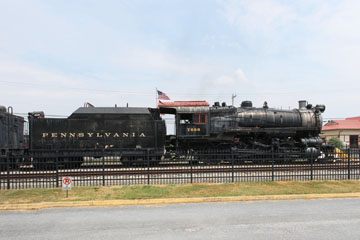
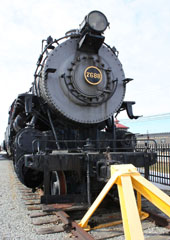

#7688 is one of twenty-five H10 class Consolidation type (2-8-0) locomotives built by Lima in 1915 for the Pennsy. The company outshopped fifteen more for the railroad in 1916.
The class was designed to haul freight in the central and western parts of the PRR system. The H10 was the last refinement of the H class and the basic freight locomotive in the area until the
1930s. #7688 was initially assigned to the Cleveland & Pittsburgh, a PRR Lines West subsidiary, hauling coal and ore between Lake Erie and Pittsburgh, PA.

Lima, Alco and PRR's Juniata Shops built more than twelve hundred H10 locomotives, but #7688 is the only known survivor.
The H10s (the "s" is for superheated) weighs 249,500 lbs, has a 55 sq ft grate, 175 sq ft firebox and heating surface of 3,016 sq ft (incl. 613 sq ft superheating).
With 62" drivers and 26" x 28" cylinders, it operated at a boiler pressure of 205 psi, delivering 53,197 lbs tractive effort.
The 181,500 lbs tender has an 81,00 gallon water and 17.1 ton coal capacity.

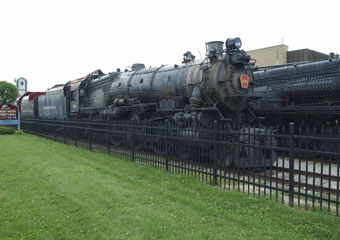
Three hundred and twenty-five K4 Pacific type (4-6-2) locomotives were built by PRR at their Juniata shops from 1914 to 1928. The first K4, #1737, was delivered in 1914, with #3750 outshopped in 1920. In addition, Baldwin built seventy-five K4s locomotives (the "s" indicated they were superheated) in 1927, and twenty-five more were built at Altoona.
The K4 was one of the most successful passenger steam locomotives ever built and outnumbered any others of its type in the US. Combining speed and power, it easily adapted to service on all parts of the vast PRR network, which included some of the country's most demanding mountain terrain. They pulled all of Pennsy's "Blue Ribbon" passenger consists. In their final years, they saw service on shorter lines, including the Pennsy's operations on the New York and Long Island Branch coast line.
The cylinders are 27" x 28" and the drivers are 80". With a 70 sq ft grate area, 305 sq ft firebox and total heating surface of 4,984 sq ft, including 943 sq ft superheating, the K4 operated at a boiler pressure of 205 psi, delivering 44,460 lbs tractive effort.
In October 1957, #3750 made its final revenue run after nearly thirty-eight years of service
and went into storage first at the West Philadelphia engine house and then at Northumberland, PA. While there, it was redesignated as K4 #1737 (originally the first of the K4s but, by then, too far deteriorated for effective restoration), and was consequently spared the torch. It resumed its original number after restoration in 1983.
Below, the sheet steel drop-coupler pilot replaced the original lattice tube cow catcher.
#3750 had long but relatively undistinguished service life plying Pennsy's metropolitan corridor between New York, NY, and Washington, DC, mainly east of Harrisburg, PA.
In 1946, it was leased to the Long Island, and returned to the PRR in 1948. It then worked in the Central Region, mostly in Ohio, before returning east in 1955, to be assigned to the New York area for several months and then to Philadelphia, where it spent its last years in passenger service working between Pemberton and Atlantic City, NJ.
Two K4s survive. #1361 went on display at Horseshoe Curve near Altoona, PA, in 1957. In 1985, it moved to the Railroaders Memorial Museum at Altoona, was restored and returned to service for excursions in 1987. In 1988, it suffered a major failure of the main bearing and drive axle. Repair work was contracted to Steamtown, in Scranton, PA, but the restoration project appears now to be dead.
Both #3750 and #1361 were designated "Official Steam Locomotives of the Commonwealth of Pennsylvania" in 1987.


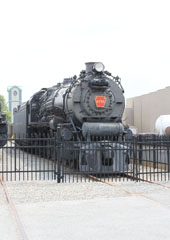
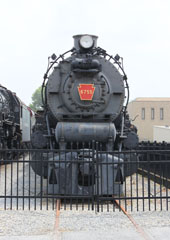
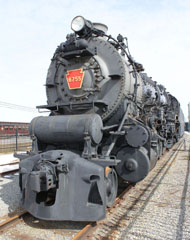
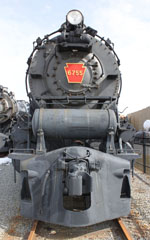
In 1930, twenty-five M1a class locomotives were ordered from Lima, fifty from Baldwin and twenty-five built at Altoona, PA, by PRR (including #6755). These featured one-piece cast cylinder saddles with inside steam delivery, Worthington feedwater heaters and two air compressors.
Thirty-eight M1a locomotives were subsequently converted to class M1b with higher-pressure boilers (from 250 psi to 275 psi) and firebox circulators. #6755 was converted in 1944 and remained in service until steam was withdrawn from the Pennsy in 1957.
#6755 is an M1b class Mountain type locomotive (4-8-2) built as an M1a by the Pennsylvania Railroad at its Juniata work shop in Altoona, PA, in 1930.
The prototype for the M1 class was built by the PRR in 1923. After exhaustive testing, the company then ordered one hundred and seventy-five of the class from Baldwin and a further twenty-five from Lima in 1926.
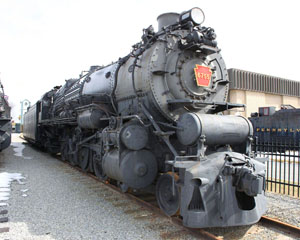
The M1 was the largest steam locomotive to operate on the PRR system and, although designed for dual service, it was used mainly on fast freight services.
The M class weighed 385,00 lbs,
although the M1 and M1a delivered tractive effort of 64,550 lbs, while the M1b delivered 69,700 lbs. The M1b weighed 391,000 lbs, 271,000 lbs on its 72" drivers. With 27" × 30" cylinders, a 69.9 sq ft grate and 397 sq ft firebox, total heating surface was 6,332 sq ft including 1,630 sq ft superheating. Originally fitted with lattice tube cow catchers, the M1 front ends underwent similar changes to the K4s, with sheet steel drop-coupler pilots, and swapping the headlight to the top of the smokebox in front of the stack and the steam-driven generator to the front of the smokebox for easier maintenance.
A wide variety of tenders were mated with M1 locomotives. All had scoops to pick up water from track pans and, at the rear, were fitted with a "doghouse" for the head-end brakeman on freight trains.

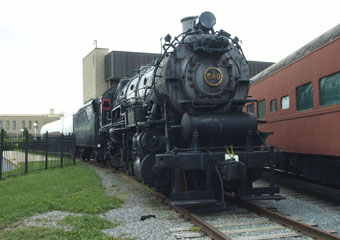

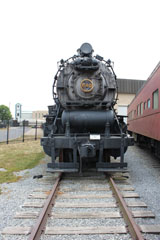
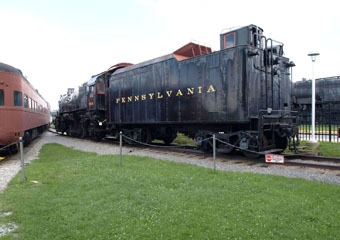
#520 is one of two hundred and five Mikado type locomotives (2-8-2) built by Baldwin for the PRR between 1914 and 1916. Three hundred and forty-four were also built at Pennsy's Juniata Shops and twenty-five by Alco. They were the largest 2-8-2s ever built.
#520 weighs 315,000 lb, 238,000 lbs on its 62" drivers. With 27" x 30" cylinders, a 70 sq ft grate, 301.5 sq ft firebox and total heating surface of 5,189 sq ft including 1,154 sq ft superheating, it operated at 205 psi delivering 61,465 lbs tractive effort.
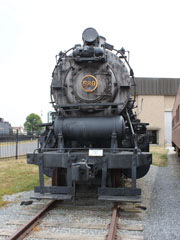
The success of the L1s was soon eclipsed by Pennsy's larger and more powerful I1s/I1sa
2-10-0 Decapods, the largest to operate in the US, which began to enter service in 1916. Many
L1s went into storage during the Depression and only returned to service with the arrival of WWII.
#520 served until nearly the end of PRR steam operations and hauled one of the last steam passenger trains on the system, a railfan special between Enola Yard in East Pennsboro Township and Northumberland, PA. It was then added to PRR's historic collection in Northumberland.


#757 is an S-2 class Berkshire type (2-8-4) locomotive built by Lima for the New York, Chicago & St. Louis Railroad in 1944.
The first 2-8-4, built by Lima in 1925 for NYC's leased Boston & Albany, inaugurated the "superpower" steam era in the US. The four-wheel trailing truck of the BA A-1 permitted a larger firebox and boiler, producing power and speed not seen before. The new wheel arrangement was dubbed the "Berkshire" after the mountain range it conquered operating between Springfield and Pittsfield, MA.
The NKP bought fifteen S class Berkshires (#700-#714) from Alco in 1934, followed in 1942 by twenty-five S-1 class from Lima (#715-#739), thirty S-2 class in 1943 (#740-#769) and ten S-3 class in 1949 (#770-#779). The last of these, #779, was the last steam locomotive produced by Lima.
The locomotive weighs 440,800 lbs, has 69" drivers and 25" x 34" cylinders. With a 90.3 sq ft grate, 461 sq ft firebox and total heating surface of 6,810 sq ft (including 1,992 superheating), it operated at a boiler pressure of 245 psi, delivering 64,135 lbs tractive effort.
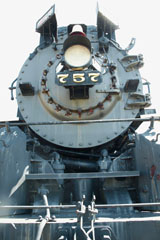
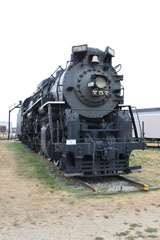
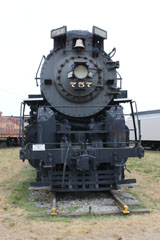
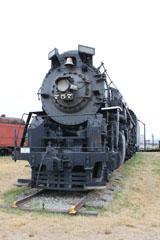
The S class were high-speed freight locomotives, with which the NKP successfully competed against the parallel lines of the much larger NYC system between Buffalo, NY, Chicago, IL, and St. Louis, MO.
#757 was gifted to the museum by the Norfolk & Western in 1966 (the NKP merged into the N&W in 1964), the first locomotive donated to the museum. It is one of five preserved NKP S-2s. You can see NKP #765 under steam on the NKP #765 page of this website, and NKP #779 in on the Steamtown page.

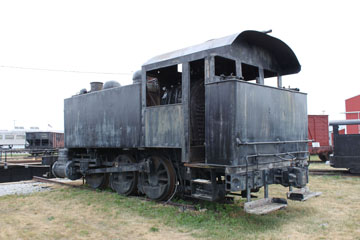
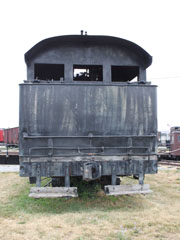
This 0-6-0T (Tank) was built as #14 by H. K. Porter in 1919 for the US Navy to operate at the Brooklyn Navy Yard. In 1922, it was sold to the Brooklyn Eastern District Terminal, which renumbered it #13.
It weighs 128,000 lbs, with 18" x 24" cylinders and 40" drivers. An oil burner operating at 180 psi, it delivered 25,865 lbs tractive effort.
In 1963, it was sold to Rail Tours Inc., to haul excursions in York, PA. It was donated to the museum in 1976. In
2011, it was donated to the Age of Steam Roundhouse in Sugarcreek, OH, where it now resides.

Both locomotives had the distinctive streamlining, but #4800 was the only unit ever to have a riveted body, giving rise to the nickname "Old Rivets". All subsequent models had welded bodies. The streamlining is usually attributed to Raymond Loewy, but a Classic Trains Magazine article by Hampton C. Wayt ('Donald Dohner: The Man Who Designed "Rivets"', Summer 2009, pp.30-35) has argued otherwise.
After testing, the GG1 went into production: although the R1 reached a higher speed (120 mph vs. 115 mph), the GG1 had better tracking.
#4800, a 2-C+C-2 type electric locomotive, was one of two prototypes ordered by the Pennsylvania Railroad for testing at Claymont, DE, in 1934. Built by Baldwin and General Electric, it was originally numbered #4899.
The design was classed GG1 by the Pennsy because the wheel arrangement was the same as two Class G (4-6-0) steam locomotives coupled back to back (you can see a G5s, #5741, on the Railroad Museum of Pennsylvania Train Shed page of this website). The other test locomotive, originally numbered #4800 was classed R1.
Twelve 385 hp GEA-627-A1 traction motors drove the six 57" driving wheels to deliver 4,620 hp, but the GG1 could achieve a maximum of 8,500 hp for short bursts.
#4800 had the distinction of hauling the first electric train out of the Washington, DC, Union Station on 28th January 1935. The Pennsy ordered fourteen more GG1s from GE but the remaining one hundred and twenty-five were built at Altoona, PA, between 1935 and 1943, with electrical components from Westinghouse in East Pittsburgh and chasses built by Baldwin.
#4800 operated until 1979, when it was retired by Conrail after forty-four years of service. In 1980, it was bought by the Lancaster Chapter of the NRHS for $30,000. Restored at Strasburg, PA, it was loaned to the museum in 1982 and donated outright in 2000.
GG1 #4935 is on the Railroad Museum of Pennsylvania Train Shed page of this website. The last GG1 to retire, #4882, is on the National NYC Museum page, #4890 is on the National Railroad Museum page and #4903 on the Museum of the American Railroad page.


PRR #3936 and #3937 (formerly #4781 and #4780) are a pair of semi-permanently coupled DD1 class electric locomotives, the only surviving examples of their class.
The DD1 was designed in 1909 to work in tunnels under the Hudson River between New Jersey and New York City, taking power from a 600 volt DC third rail rather than an overhead catenary.
The 315-A 2,000 hp engines were supplied by Westinghouse, and the running gear and cabs were built at Pennsy's Altoona shops. The first two units were tested in 1909 and twenty-five were subsequently ordered that year for delivery in 1910.

Each unit was 64' 11" long, with a 55' 11" wheelbase, and weighed 313,000 lbs.
Below, each unit's motor drove the locomotive through a jackshaft and side rods connected to the 72" drivers. With a starting tractive force of 66,000 lb, they had a top speed of 85 mph.
The DD1s operated between Manhattan Transfer and Pennsylvania Station, and from there to PRR's coach yards at
Sunnyside Yard in Queens.
DD1s ceased operating on mainline passenger services in 1924 when PRR's thirteen L5 units appeared. However, they still hauled empty passenger trains from Penn Station to the Sunnyside Yard, and their simplicity and reliability meant they actually outlasted the L5 units by some years.
#3936 and #3937 were donated to the museum by PRR's successor, Penn Central, in 1979.



When Amtrak started operations on 1st May 1971, it initially utilised an aging fleet of GG1 locomotives for its electrified passenger service between New York, NY, and Washington, DC. Looking to replace these, however, the company ordered a set of new E60 units.
Twenty six of these 6,000 hp units were built by General Electric at their works in Erie, PA, between 1974 and 1976 (#950-#975). Seven (#950-#956) were fitted with steam generators to heat older passenger cars and designated E60CP. The other nineteen had head end generators for newer passenger cars and were designated E60CH (#957-#975).
The E60 was based on existing locomotives GE had designed for freight, but their 387,000 lb as-built weight was more than double the optimum for passenger service and caused poor running during testing. The engines tended to yaw when accelerating, placing high stress on the rails, and the FRA refused to let them to operate at their designed speed of 120 mph after they derailed twice during testing.
After further refinements and tests, the units entered service at slightly reduced speeds, but then encountered new problems when turning on the tight radius return loops at Sunnyside Yard, New York.
From 1986 to 1988, the remaining E60s were rebuilt. The E60CPs had their steam generators removed and four had head end heating fitted. The original E60CH and converted E60CP units were then redesignated E60MA ("MA" stood for Motor Alternating set), and were renumbered in the 600 series.
By 2003 only a handful of E60s continued to operate. They were scheduled for overhaul and new cab signal equipment to permit 120 mph running, but none of the overhauls was fully completed when it was decided to scrap the fleet.
They had been designed for close coupling with passenger equipment, but actually coupled so closely that the diaphragms on the coaches would sheer the headlights off the locomotive's nose. All headlights were subsequently moved above the cab windows.
The E60s ran until 1984, when most were put into storage. With the arrival of its new AEM7 electrics in 1984, Amtrak then began to dispose of the units. Ten were sold to New Jersey Transit in 1984, and two to the Navajo Mine Railroad in New Mexico.
#603 was originally an E60CH numbered #974 and became E60MA #603. It was bought by the museum in 2003 and delivered in early 2004.
NJT E60 #958, is preserved by the United Railroad Historical Society of New Jersey and is stored in Morristown, NJ.

Amtrak inherited high-speed operations on the Northeast Corridor from bankrupt Penn Central in 1971. Electrified passenger services between New York, NY, and Washington, DC, were handled by new Budd Metroliner electric multiple units and aging PRR GG1s. Amtrak's first replacement for the GG1 was the GE E60, delivered in 1974.
However, these proved unable to safely exceed
100 miles per hour and they were consequently relegated to hauling slower, long-distance
services (AMTK GE E60 #603 is shown earlier on this page).

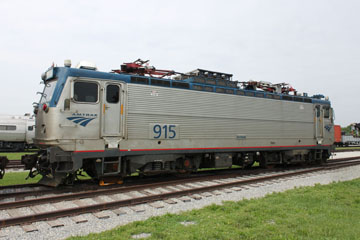
Amtrak then turned to Europe, and brought two units for trials in 1976-77: the Swedish Rc4 (numbered X995), and the French CC 21000 (X996). Amtrak favoured the Swedish design, which formed the basis for the 7,000 hp AEM7, sixty-five of which were built by EMD from 1978 to 1988 under licence from Swedish manufacturer ASEA.
The bodies were built by the Budd Company, with trucks, electrical and mechanical parts from Sweden. The Swedish influence led to the nickname "Meatball", after Swedish meatballs, but rail fans nicknamed the boxy units "toasters".
The first AEM7 (#900) went into service for
Amtrak in 1979 and, between 1980 and 1982,
forty-six more went into service (#901-#946).
The final seven were delivered in 1988. Two
other commuter operators in the Northeast
ordered AEM7s: MARC ordered four in 1986 for
its Penn Line service between Washington, DC,
and Perryville, MD, and SEPTA ordered seven in 1987.
#915 arrived at the museum in June 2015. It is one of the original DC propulsion units, rather than the later modified AC propulsion units.

#1200 was the first of two demonstrator units built by BLH in 1951. The second was #1201.
Both were sold to the Rock Island in 1953. Renumbered #758 and #759, they entered service switching at Blue Island, IL, and were the only S-12s to operate on the Rock Island.
#1200 is a 1,200 hp S-12 switcher built by the Baldwin-Lima-Hamilton Corporation. It is an upgraded version of a predecessor unit, the 800 hp S-8, similar in size and mechanics but with increased horsepower.
Although it was the last model produced by Baldwin, which merged with Lima-Hamilton in
1950, the S-12 was relatively successful. Four hundred and fifty-two of the units were produced between 1951 and 1956, all for US railroads. The largest order of eighty-seven units went to the Pennsy.
The S-12 is 48' long and weighs 240,000 lbs. A six cylinder De LaVergne 606A SC prime mover powered a Westinghouse WE480 generator to drive four Westinghouse WE362 traction motors. Each truck was fitted with 40" wheels and had a wheel base of 8'. The locomotive could deliver 34,000 lbs continuous tractive effort at 10.8 mph, and had a top speed of 60 mph.
Seven S-12s have survived. You can see the last
S-12, Erie Mining Company #7243, on the Lake Superior Railroad Museum page of this website. It is the last locomotive ever built by Baldwin.
#758 was sold to the US Navy in 1959, and #759 was retired by the Rock Island in 1966.
#758 was donated to the museum in 1992 by the US Navy Ordnance Depot in Earle, NJ, and repainted in its original Baldwin livery as #1200. The locomotive remains serviceable.

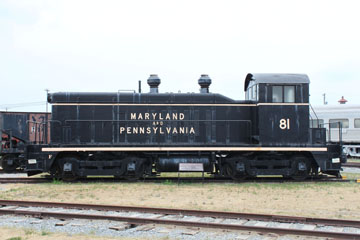
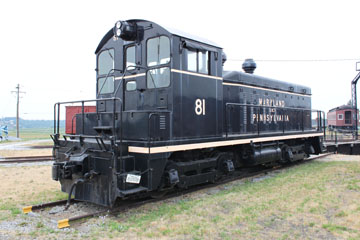
This EMD NW2 switcher is one of two (#80 & #81) delivered to the Maryland & Pennsylvania Railroad in 1946. It was leased to the P. H. Glatfelter Company in Spring Grove, PA, in 1986. The company donated it to the museum in 1997.
The NW2 weighs 248,000 lbs. With an EMD 12-567 prime mover powering a GM D15C generator to drive four GM-D37 traction motors, it developed 31,000 lbs continuous tractive effort at 11 mph with a top speed of 65 mph. One thousand, one hundred and forty-five were produced from 1939 to 1949, one thousand, one hundred and twenty-one for US railroads and twenty-four for Canada.
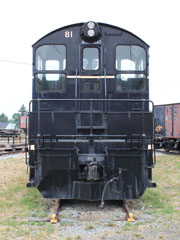
The Maryland & Pennsylvania Railroad, affectionately known as the "Ma and Pa", was a shortline railroad connecting York, PA, and Baltimore, MD. It operated from 1901 into the 1950s. Passenger services ended in 1954, the first section of line was abandoned in 1958 and most of the remaining line had gone by 1984.
The "Ma and Pa" was popular with railfans in the 1930s and 1940s because of its
antiquated equipment and a particularly picturesque line, which snaked south through the hills of rural
Maryland and Pennsylvania.

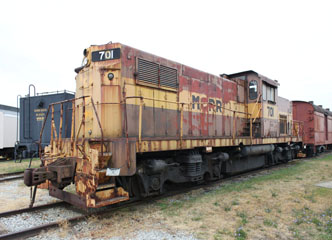
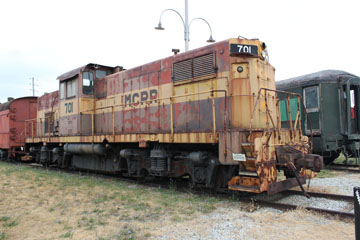
MCRR #701 is an Alco built C-415 switcher with a
4-cycle Alco 251-F prime mover powering a GE GT581 generator to drive four GE 752 traction motors, one on each axle. It weighs 240,000 lbs and delivers 42,000 lbs continuous tractive effort at 10 mph with a top speed of 66 mph.
The C-415 was not a popular locomotive: only twenty-six were produced between 1966 and 1968 for seven different owners, including Hamersley Iron, headquartered in Perth, Australia. #701 was delivered to the Monongahela Connecting Railroad in 1968.
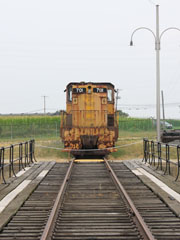
The Monongahela Connecting Railroad was a small industrial
railroad with a line in downtown Pittsburgh,
PA. It was a subsidiary of Jones & Laughlin Steel Company, although it also served other industries along the route.
The MCRR was also an early pioneer of dieselisation, buying many early production models from Alco, GE and other
manufacturers.
Now part of the Allegheny Valley Railroad, what remains of the MCCR serves a few small industrial customers along the north bank of the Monongahela River.

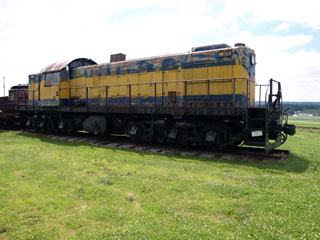
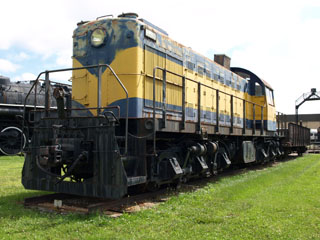
This unit started life as an Alco RS-1, a
4-axle diesel-electric unit. Four hundred and sixty-nine of these were built by Alco-GE between 1941 and 1953, and then by Alco from 1953 to 1960, making it the longest production run of any diesel locomotive for the North American market.
The RS-1 also pioneered the road switcher type, and most switchers built since then have followed the design. The set-back cab provides greater safety in the event of a collision than earlier switchers, and rear visibility is much better than in a cab unit.
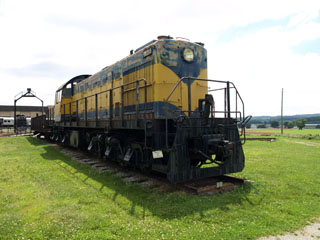

The first thirteen RS-1s were requisitioned by the US Army in 1942 and remanufactured by Alco into six axle RSD-1s for the Trans Iranian Railroad to supply the Soviet Union during WWII. Built for the Atlanta & St. Andrews Bay Railroad, this unit was one of the thirteen and, as US #8011, it spent most of the war on the Trans Iranian Railroad.
You can see TXIX RSD-1 #8000 on the Museum of the American Railroad, OERM RSD-1 #1975 on the Orange Empire Railroad Museum and USA RSD-1 #8651 on the National Railroad Museum pages.
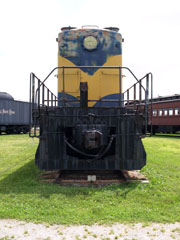
After the war, it was stored for six years, then worked for the Alaska Railroad as #1034 for five years, then returned to the US Army in 1956.
In 1974 it went to Pueblo, CO, as DOT #103. In
1984, it was the first diesel to enter the Smithsonian collection and was on loan when I visited. It has
moved to the US Army Museum of Transportation in Fort Eustis, VA.
54' 11" long and 204,000 lbs, its 539T-6L 4-cycle prime mover powered a GE GT553C generator to drive four GE 731
traction motors delivering 34,000 lbs tractive effort at 8 mph with a top speed of 60 mph.

Designed for long-distance commuter or short-distance intercity travel, they operated on PRR's Harrisburg-Philadelphia, PA, route. Each coach is 85' long, with two rows of twenty-five seats and a control cab at each end. They could operate as single car trains or in sets of up to six cars. Although they had an advertised speed of 100 mph, in operation, they ran at 80-85 mph.
The thin stainless steel carbody and light traction components resulted in these being the lightest all metal EMU railroad passenger cars produced in North America.
These EMU (electric multiple unit) Pioneer III coaches were two of six units built for the Pennsy by the Budd Company in Philadelphia, PA, in 1958 numbered #150-#155. The even-numbered cars had fabricated truck frames and disc brakes, designated MP58E. The odd-numbered cars had cast steel truck frames and tread brakes, designated MP58AE.
They rode on Budd Pioneer III lightweight trucks designed for operating at speeds up to 125 mph. Power was supplied from an overhead pantograph like that on all other PRR long distance electrified motive power.
However, there were reliability and performance issues with the Pioneer III's small traction motors and low capacity main transformer.
In 1963, the PRR purchased a more advanced version of the Pioneer III design from Budd. Using the Pioneer III as a model, the thirty-eight new "Silverliner" cars, as the new coaches were called, had more powerful traction motors and used "spear" couplers in place of the "knuckle" design. The PRR then took the Pioneer III cars off intercity operations and used them exclusively on the Philadelphia area commuter service.

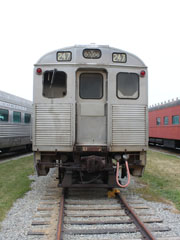
In 1967, when the South East Pennsylvania Transport Authority and PRR took delivery of a second "Silverliner" order from the St. Louis Car Co., the 1963 "Silverliner" cars became "Silverliner II" cars and the 1967 order, "Silverliner III".
The 1958 Pioneer III were then retroactively given the "Silverliner I" designation. As part of the Penn Central merger, they were also renumbered in non-sequential order to #294-#299. After delivery of the "Silverliner IV" cars from GE in 1974-75, the Pioneers were again renumbered #244-#248 (one unit had been retired after a train wreck).

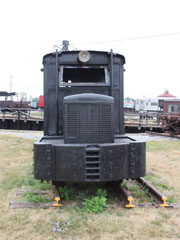
This 5 ton narrow gauge (36") switcher was built for the Lone Star Cement Co., by the Brookville Locomotive Works of Brookville, PA, in 1951. It was donated to the museum in 1997 by Thomas Henning.
Begun in 1918,
Brookville was originally a Ford dealership and simply fixed railroad wheels to Ford trucks. However, this grew into a business fitting unfinished truck or tractor chasses with their own underframes, rail wheels and drives. During the early 1930s, they started building entire locomotives, using outside suppliers for engines and transmissions.

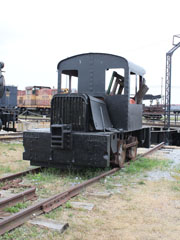
Built in 1930 by the Vulcan Iron Works in Wilkes-Barre, PA, this little diesel engine spent its entire operating life switching at the Vulcan Iron Works Valley Shop.
It was retired in the 1960s and, in 1973, was bought by Harold Cox and Ed Blossom, who moved it to Dushore, PA, where they were restoring streetcars.
Blossom then donated it to the Electric City Trolley Museum in Scranton in the 1990s, where it was to be used to move trolley cars in places where there were no overhead wires.
Declared surplus, it was donated to the railroad museum in 2006.


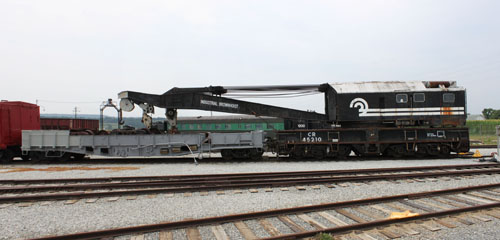
The Industrial Brownhoist Company, Bay City, MI, built this crane for the Erie Lackawanna in 1954. Numbered #03302 and based in Meadville, PA, it transferred to Conrail in 1976 and was renumbered #50212. Conrail based it in Conway, PA, and at some time, it was renumbered #45210.
#45210 weighs 192 tons, is powered by
two 140 hp Cummins engines and has a lifting capacity of 250 tons at a 17' 6" radius.
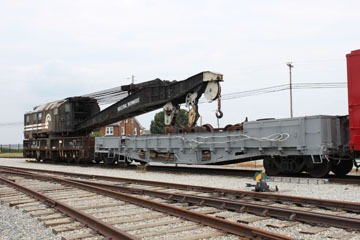
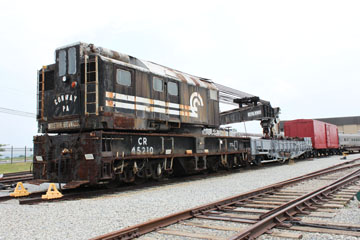
Conrail donated #45210 to the museum in 1997. It is on display with Conrail idler car #31188, formerly PRR #470189.
Industrial Brownhoist were a major supplier of cranes to the railroad industry and many have been preserved. You can see more on the B&O Museum Yard & Car Shop page of this website, the IC #2542, the Nevada Northern Railroad Museum, the Lake Superior Railroad Museum, Virginia Museum of Transportation, Gold Coast Railroad Museum, Ogden Union Station, Monticello Railway Museum and National Railroad Museum pages.
Related Links:
Railroad Museum of Pennsylvania Website
Pennsylvania Railroad Technical & Historical Society
Maryland and Pennsylvania Railroad Preservation Society
Alaska Railroad Fan Page
Nickel Plate Road Historical & Technical Society
Conrail Historical Society
Amtrak Historical Society
Send a comment or query, or request permission to re-use an image.
In 1977, Karl Zimmerman produced The Remarkable GG1 published by Quadrant Press (click on the cover to search for this book on Bookfinder.com).

PoathTV has uploaded PRR's 1946 Clear Track Ahead! to YouTube. Click to see this overview of the Pennsylvania Railroad from its inception through to the mid 1940s.






